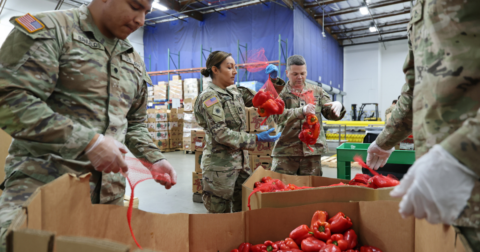News
Senate Finally OKs Plant-Based Milk in Public Schools
Policy•5 min read
News
The Trump administration’s USDA is refusing to release around $6 billion in contingency funds designated for a lapse in SNAP benefits.


Words by Grey Moran
A deleted plan from the U.S. Department of Agriculture (USDA) suggests that the Trump administration had intended to release contingency funds to keep the Supplemental Nutrition Assistance Program (SNAP) running during a government shutdown. Without those funds, millions of Americans — including nearly 16 million children — are slated to lose access to food assistance on Nov. 1. It’s an unprecedented move. In past shutdowns, SNAP benefits continued uninterrupted with the assurance of contingency funds, which are emergency reserves authorized by Congress for that purpose.
The 55-page deleted plan, dated September 30th, 2025, calls for the “core programs of the nutrition safety net, including the Supplemental Nutrition Assistance Program (SNAP), the Child Nutrition (CN) programs and the Special Supplemental Nutrition Program for Women, Infants and Children (WIC)” to continue during a lapse in funding. Not only does the plan call for a retention of SNAP benefits, but it also details the legal justification for the release of contingency funds available for disruptions to the program.
“Congressional intent is evident that SNAP’s operations should continue since the program has been provided with multi-year contingency funds that can be used for State Administrative Expenses to ensure that the State can also continue operations during a Federal Government shutdown,” states the deleted plan. “These multi-year contingency funds are also available to fund participant benefits in the event that a lapse occurs in the middle of the fiscal year.”
On October 24th, the USDA quickly reversed course on this plan in a memo claiming that the “contingency fund is not available to support FY 2026 regular benefits,” — without providing any legal justification.
The USDA’s webpage, which previously linked to the contingency plan, has been replaced with a notice, relying on inflammatory rhetoric to blame immigrants and transgender people for the lapse in SNAP funding:
“Bottom line, the well has run dry. At this time, there will be no benefits issued November 01. We are approaching an inflection point for Senate Democrats. They can continue to hold out for healthcare for illegal aliens and gender mutilation procedures or reopen the government so mothers, babies, and the most vulnerable among us can receive critical nutrition assistance,” states the federal department’s website.
Forty-six Senate Democrats and 214 House Democrats have signed letters to the Trump administration urging the USDA to use the contingency funds to release SNAP benefits.
Meanwhile, a group of Attorneys General and governors from 25 states filed a lawsuit on October 28th challenging the administration’s refusal to release SNAP contingency funds as illegal, citing the deleted plan from the USDA’s website. The lawsuit claims that Congress has appropriated “$6 billion to the USDA for a SNAP-specific contingency fund” and that “much of these contingency funds—if not all—remains available to fund SNAP benefits and State administrative costs.”
“The Trump administration has hit a new low with their policy to not fund food stamps and SNAP services when they can. They can. In fact, they must, according to the law, but they are going out of their way with cruelty as the policy and cruelty as the point,” said California Attorney General Rob Bonta, who is a plaintiff in the lawsuit, at a press conference held at Los Angeles Regional Food Bank. In the background, the National Guard unloads boxes of bell peppers.
A federal court in Boston issued a memorandum on Friday determining that the plaintiffs are “likely to succeed on their claim that Defendants’ suspension of SNAP benefits is unlawful.” The judge ordered the Trump administration to respond by Monday regarding whether they plan to release at least partial November SNAP benefits. Even if the emergency SNAP benefits are released, there would likely still be an administrative delay in the disbursement of funds.
The looming cutoff of SNAP benefits comes during a time of year when most families tend to struggle the most with affording groceries. While food banks and mutual aid efforts have stepped up across the country, the cutoff is still expected to have a devastating impact. One in every 8 people in the U.S. relies on SNAP, and 39% of its recipients are children.
“We’re heading into, of course, the holiday season. Kids are about to be home from school for Veterans Day, then Thanksgiving break, closely followed by winter break,” said Bonta, in the center of the bustling food bank warehouse.
“And no school means no school breakfast. No school means no school lunch that so many families rely on.”